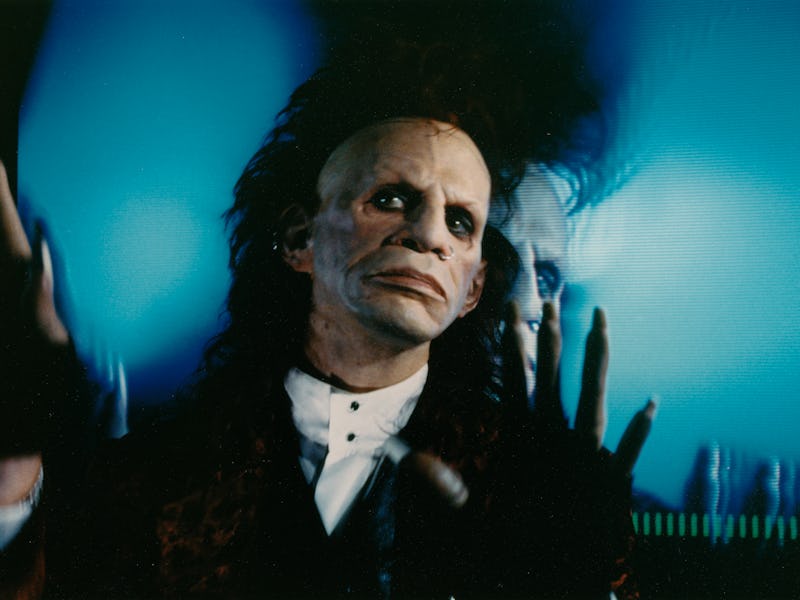30 Years Ago, Edward Furlong Squared Off Against Another CGI Villain
It’s no Terminator 2, but Furlong’s lesser-known sci-fi contains some entertaining scares.

The computer-generated villain was all the rage in the early ‘90s, as Hollywood got carried away with the possibilities of the internet, AI, and VR technology. Just ask Edward Furlong. The troubled star had to contend with arguably the most fearsome technological foe, Robert Patrick’s shape-shifting T-1000 in Terminator 2: Judgment Day, before doing battle with a more cartoonish evildoer in the less celebrated Brainscan.
The sci-fi slasher stars Furlong as Michael Brower, a reclusive teenage orphan who spends his downtime either perving over his high school crush or immersing himself in the world of horror movies and video games. Little wonder, therefore, that he becomes intrigued when Brainscan, an immersive POV title that allows the player to inhabit the mindset of a voyeuristic serial killer, hits the shelves (well, the mail-order catalog).
Of course, the boundaries between fantasy and reality begin to blur when, after slicing up a sleeping middle-aged stranger (and keeping a foot as a macabre trophy) in the game, a shocked Michael learns a local man has suffered the same unfortunate fate in reality. Is it a remarkable coincidence, or did Brainscan coerce him into committing homicide? The five toes in his isolated mansion’s freezer suggest the latter.
Michael’s worst fears aren’t exactly allayed by the game’s maniacal host, The Trickster (T. Ryder Smith), particularly when he metamorphosizes from a bunch of pixels into a physical being before his very eyes. Best-known for his work in various avant-garde stage productions, Smith has a blast taunting and terrorizing Michael, his leather-clad, heavily scarred appearance channeling everyone from Freddy Kreuger and Alice Cooper to Max Headroom and Howie Mandel’s snot-nosed boogeyman in Little Monsters. It’s an admirably no-holds-barred performance deserving of a better film and a few sequels.
Edward Furlong and a slightly meta magazine article.
Unfortunately for Michael, The Trickster’s mind games only get worse. Michael wakes up one morning to discover his fellow misfit Kyle (Jamie Marsh) has also been violently murdered, and the blood-soaked souvenir in his possession once again frames him as the number one suspect. He only just stops himself from adding the object of his affection, Kimberly (Amy Hargreaves), to his kill list following a physical struggle that reveals The Trickster is a sinister part of his own consciousness. The resulting sequence, in which the latter tries to devour Michael whole, provides the film’s only genuine scare.
Unfortunately, this is where Brainscan loses all the goodwill Smith has built up, adopting the same inexcusably lazy narrative trope that turned Dallas into a laughing stock. Yes, just like Pam Ewing waking up to find her “dead” husband Bobby in the shower, Michael discovers it’s all been in his imagination. There’s no footless corpse, Kyle is still in one piece, and he hasn’t spent the last week being goaded by a malevolent entity with an extreme mohawk.
So what was the point of it all? A commentary on the corrupting power of computer games? Only a year earlier, the full-motion video game Night Trap had whipped the media into a frenzy, prompting a U.S. Senate committee hearing on video game violence, and ultimately producing the Entertainment Software Rating Board. Possibly, although the fact Brainscan gives Michael the courage to ask Kimberly out instead of spying on her with various bedroom gadgets doesn’t seem like a particularly obvious deterrent.
T. Ryder Smith with the horror genre’s most impressive red mohawk.
Perhaps a cautionary tale on the influence of horror movies? Michael is disciplined by principal Dr. Fromberg (David Hemblen) for bringing a (sadly fictional) film named Death, Death, Death Part II to his lunchtime club. Again unlikely, as Brainscan appears to be having its cake and eating it. “The activities period was created for intellectual enrichment... Violence is not senseless entertainment!” Fromberg barks in a picture that revels in eye-gouging, decapitation, and self-cannibalism.
Alongside an aimless narrative, Brainscan is also hampered by the charisma void of its leading man. “Eddie Furlong was a 15-year-old kid who couldn't act,” remarked its director John Flynn, the man then best-known for the Quentin Tarantino-approved exploitation flick Rolling Thunder. “You had to slap him awake every morning.” And it’s hard to disagree, especially when Michael reacts to the horrifying prospect of having just murdered his best friend with a curious mix of soap opera histrionics and nonchalance.
Brainscan has a few other joys, both intentional and unintentional. Frank Langella brings a bit of gravitas to proceedings as the grouchy detective hot on Michael’s trail, and it’s fun to see all the period signifiers, from the Aerosmith posters that appear to emblazon every kid’s wall, to the pivotal use of CD-ROMs and a second-tier grunge soundtrack. But by the time The Trickster pops up again in the closing shot, hinting at a sequel that never materialized, it feels as though your own brain scan would show fewer cells.